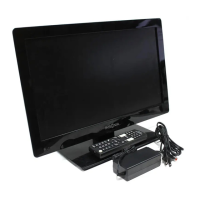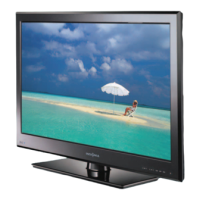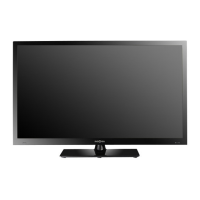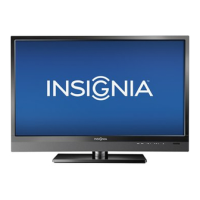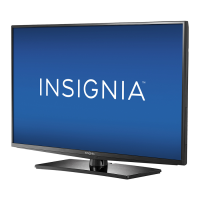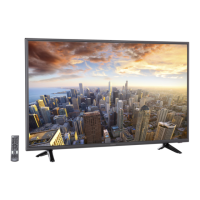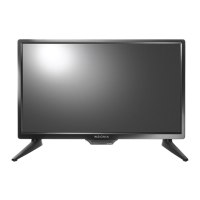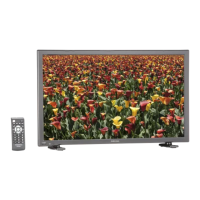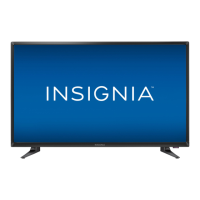
Do you have a question about the Insignia NS32D311NA17OM and is the answer not in the manual?
HDMI CEC compatible products plug and play feature.
Audio technology for clear, crisp sound with deep bass.
Automatically adjusts TV picture settings for optimal video game experience.
Instructions for attaching the TV stands to the bottom of your TV.
Conditions requiring qualified service personnel for TV repair.
Keep mobile phones away from TV to avoid interference and damage.
Ensuring correct parts are used for TV repairs to avoid hazards.
List of items included in the TV package.
Identification of components and indicators on the front of the TV.
Instructions for connecting a cable/satellite box via HDMI for optimal video.
Instructions for connecting a DVD/Blu-ray player via HDMI for optimal video.
Instructions for connecting a game console via HDMI for optimal video.
Instructions for connecting external speakers/soundbar via digital optical audio.
Guide to inserting batteries into the remote control.
Instructions on how to point the remote at the TV's sensor.
Steps to operate the TV with a new or existing universal remote control.
How to find universal remote control codes in the on-screen menu.
Creating custom labels for connected input sources.
Procedure for powering the TV on, off, and into standby mode.
How to choose the active video input source for connected devices.
Overview of options available in the Picture and Audio menus.
Overview of options available in the Channels and Settings menus.
Overview of options available in the Help and Photos menus.
How to navigate through and select TV channels.
Instructions for increasing, decreasing, or muting the TV volume.
How to display program and signal information banners.
Enabling or disabling HDMI CEC control for connected devices.
Automatically turning off HDMI CEC devices when the TV is turned off.
Viewing a list of connected HDMI CEC compatible devices.
Choosing which connected HDMI CEC device to use.
Accessing the TV's USB port for media playback.
Navigating through JPEG photo files on a USB drive.
Creating and viewing a slideshow of photos from a USB drive.
Fine-tuning various settings for optimal TV picture quality.
Selecting predefined picture modes like Vivid, Standard, Movie, Game, Custom.
Modifying audio settings for improved sound quality.
Choosing the audio output method for headphones or external speakers.
Disabling the TV picture to listen to audio only.
Searching for and storing available TV channels.
Skipping specific channels in the channel list.
Establishing or modifying the parental control password.
Enabling or disabling closed caption text display.
Choosing caption display modes for analog TV channels.
Manually setting the TV's current date and time.
Configuring the TV to automatically turn off after a set time.
Changing the on-screen menu language (English, French, Spanish).
Accessing details about the TV's model, revision, and firmware.
Finding information on remote codes and connecting a soundbar.
Troubleshooting issues with picture aspect ratio and screen fill.
Diagnosing and resolving problems with no video or audio output.
Addressing issues related to dim, unclear, or distorted picture.
Resolving problems with inaccurate or missing color in the picture.
Troubleshooting issues with static or graininess appearing on the TV screen.
Addressing variable picture quality on different TV channels.
Resolving interference patterns like lines or stripes on the TV display.
Troubleshooting issues causing duplicate or ghosted images on screen.
Understanding normal pixel variations on LCD screens.
Resolving issues where the TV displays video but has no audio.
Troubleshooting picture quality and color reproduction problems.
Diagnosing and fixing unwanted noise or static in the TV audio.
Troubleshooting why one or both TV speakers are not producing sound.
Understanding and preventing screen burn-in or persistent images.
Resolving issues where the remote control is unresponsive.
Troubleshooting problems programming universal remotes for the TV.
Addressing common problems like no channels, grayed inputs, lost passwords, and cabinet noise.
Resolving issues with the TV's /INPUT button functionality.
Troubleshooting the TV shutting off on its own.
Resolving the display of a retail banner instead of normal TV content.
Troubleshooting problems with video from connected CEC devices.
Troubleshooting problems with audio from connected CEC devices.
Resolving issues where the TV remote doesn't control connected devices.
Troubleshooting why connected CEC devices don't show in the INlink device list.
Resolving issues where connected CEC devices don't power off with the TV.
Troubleshooting why the TV doesn't power on when a connected CEC device is turned on.
Resolving problems with the Audio Receiver setting in the INlink menu.
Understanding the appearance of two volume bars during adjustments.
Physical dimensions and weight of the TV with and without the stand.
Details on screen size, panel type, refresh rate, and resolution.
List of available input and output connection ports on the TV.
Details on audio output and power consumption.
Other technical specifications like OSD languages and VESA mount.
Compliance information regarding radio frequency interference.
Regulatory compliance information for Canada.
Notices for Dolby, HDMI, and DTS trademarks and licenses.
Details regarding the open source software used in the TV.
Details on the length of the warranty period from the purchase date.
Information on what defects and damages are covered under the warranty.
Instructions for getting repair or replacement service for the product.
Information on what is NOT covered by the warranty.
List of available video and audio output connections.
Details on DTS tuning package and speaker output.
Information on power consumption and input requirements.
Details on OSD languages, INlink, Game Mode, and VESA mount.
Compliance information regarding radio frequency interference.
Notices for Dolby trademarks and licensing.
Information regarding HDMI multimedia interface trademarks.
Information regarding DTS Sound trademarks and patents.
Details regarding the open source software used in the TV.
Key terms used within the limited warranty statement.
Details on the length of the warranty period from the purchase date.
Information on what defects and damages are covered under the warranty.
Instructions for getting repair or replacement service for the product.
Geographical limitations for warranty service validity.
List of conditions and damages excluded from warranty coverage.
